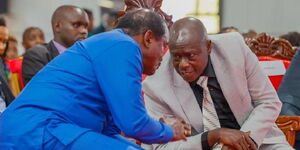As the government continues with the implementation of the Competency-Based Curriculum (CBC), the Ministry of Education has unveiled comprehensive guidelines detailing the transition of learners from junior to senior secondary school.
This initiative aims to align educational pathways with students' individual strengths and career aspirations, marking a pivotal shift in the nation's educational framework.
The pioneer cohort, currently in Grade 9, is slated to join Grade 10 in January 2026. To facilitate a seamless transition, these learners will undertake the Kenya Junior Secondary Education Assessment (KJSEA) between October 27 and November 5, 2025.
The KJSEA's comprehensive evaluation structure comprises 20 per cent from the Kenya Primary School Education Assessment (KPSEA), 20 per cent from school-based assessments in Grades 7 and 8, and 60 per cent from a summative evaluation at the end of Grade 9.
Central to the CBC is the emphasis on career-oriented pathways. Students are presented with three primary options: Science, Technology, Engineering, and Mathematics (STEM); Arts and Sports Science; and Social Sciences.
The Ministry of Education anticipates that 60 per cent of learners will gravitate towards STEM, 15 per cent towards Arts and Sports Science, and 25 per cent towards Social Sciences. Each pathway is meticulously designed to cater to diverse academic and career interests, ensuring students receive tailored education that prepares them for higher education and the evolving job market.
In preparation for their transition, learners will select a total of 12 senior schools based on their preferred career pathways. This selection is stratified into seven schools for their first-choice pathway and track, three for their second choice, and two for their third choice.
Of these, nine are designated as boarding schools—four within the learner's home county and five outside—while the remaining three are day schools situated in their home sub-county or county of residence.
The placement process is intricately linked to the learners' performance in the KJSEA. High achievers, particularly the top two learners per gender in each STEM track per sub-county, will have the privilege of placement in a boarding school of their choice.
Similarly, the top-performing learner per gender in both the Social Sciences and Arts and Sports Science tracks per sub-county will also secure placement in a boarding school of their preference.
To promote diversity and equitable distribution, the guidelines stipulate that no more than five learners from the same junior school shall be placed in the same boarding institution. This measure ensures a balanced representation of students across various schools, fostering a rich exchange of ideas and cultures.
Recognising the unique needs of learners with special requirements, the Ministry has outlined provisions to support their educational journey. Candidates with higher achievement levels will be placed in schools that cater specifically to their needs, ensuring they receive the necessary support and resources to thrive academically and socially.
The curriculum for senior school learners, spanning Grades 10 to 12, mandates the undertaking of seven subjects. Four of these are core subjects: English, Kiswahili or Kenya Sign Language (KSL), Community Service Learning, and Physical Education. The remaining three subjects are selected based on the learner's chosen pathway and specific track, allowing for specialized focus in areas of interest.
In a move towards modernisation and efficiency, the Ministry has implemented an automated system for the admission process. Learners can access their admission letters online using their assessment numbers, streamlining the transition and reducing administrative bottlenecks.
To ensure transparency and address potential concerns, the Ministry has established a grievance redress mechanism. Parents and learners dissatisfied with placement outcomes can channel their grievances through the learner's junior school headteacher, who will then forward them to the County Director of Education for resolution.












